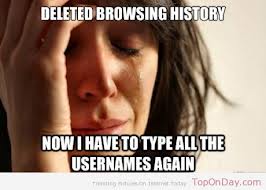If your computer crashed right now, what would you do? Could you recover everything that was lost, or would you lose years of family photos, work you’ve done for school, and other irreplaceable items?
I had to ask myself those questions this week when my beloved 2.5 year-old MacBook Pro experienced a series of fatal errors. I’ve been on the phone with Apple and running back and forth to the Apple store almost every day talking about kernel panic, logic board replacement, and total hard drive failure. Sigh. First world problems, I know.

The bright spot in all of this (well, besides the fact that the computer is still under warranty!) is that every time we attempted a fix and an Apple employee asked, “Is everything backed up?” I could say with relief, “Yes, absolutely everything.” That wasn’t always the case. Backing up one’s computer used to be a tedious and sometimes expensive ordeal that was just too much trouble for the average user, and I didn’t learn my lesson until my PC crashed in 2009 and I lost tons of music, photos, and school files. Ever since then, I’ve been serious about backing up my files, and it’s been worth every second of my time investment. And these days, it’s incredibly easy to save everything that’s on your computer automatically.

Here are three easy ways I make sure my computer files and settings are always backed up:
1) Save everything to an external hard drive once or twice a month.
With Macs, you can use Time Machine, which allows you to simply hook up your external drive and have every single thing (files, programs, settings, passwords, internet history, etc.) transferred. (If you have a PC, you can drag and drop files to the external drive.) If I ever need to access a file I deleted months ago, I can get it back with no problem. And if my computer ever has its hard drive replaced and all my data gets erased (which is happening right now), I can just hook up the computer to my external drive and everything will be automatically restored. Whew. I’ve used cheap back up drives before and had them stop working, so now I use this LaCie model. This was the only financial investment I had to make in backing up my computer and it’s been totally worth it, especially since the 2 TB of storage (over 2,000 GB) is enough for my husband to use as his external drive, too. So, all our pictures, videos, and music get saved on the backup drive and we don’t have to worry about losing anything of sentimental value.

2) Use Dropbox to automatically sync files to the cloud.
Dropbox is pretty much the greatest invention ever, and it’s totally free! I installed my Dropbox folder on my desktop and save ALL my files there (personal and for work), creating sub-folders so everything stays organized. The second I save a file, it automatically syncs to Dropbox’s online server (the “cloud”), and I can then access the file from any internet-connected device in the world. That means whatever’s on my MacBook can also be viewed on school computers, on my iPad, etc. And I don’t have to remember to back anything up–it happens without me doing a thing. Dropbox means no more emailing files to yourself or getting viruses from USB/flash drives. Woohoo! Here’s a quick tour:
If you decide to sign up for Dropbox, please use the link here. I don’t get paid in any way to promote Dropbox, but you and I will BOTH get an extra 500 MB of free storage if you sign up through my referral link.
3) Use Google Chrome for browsing the internet.
Many people don’t think about backing up their internet history, logins, and passwords, but since most computer time is spent online, losing your bookmarked sites and web settings can be extremely frustrating. For me, Chrome has been the best solution. There are dozens of reasons to use Chrome instead of Firefox or Safari (and about a million reasons to use it instead of Internet Explorer), but for our purposes here, I’ll just mention how easy it is to keep your internet settings when you use Chrome. You can login to Chrome on any computer and see all your bookmarks, web history, internet searches, passwords, and so on. It works seamlessly with your Google Account (which I use for Gmail, Google Drive, and so on). This means that whenever I logon to a new computer, I can just open Chrome and sign in, and everything about my internet experience is like I’m on my own laptop. Take a tour of Google Chrome, or if you don’t want to switch browsers, try using Firefox Sync.

These three tools have meant that being without my MacBook right now isn’t too much of a pain, because all my internet preferences are accessible on any computer via Google Chrome, and all my files are available through Dropbox. And when my laptop comes back from Apple with a new hard drive, getting everything back the way I want it will be simple. I’ll attach my external drive and the computer will import all my programs, settings, etc. (even my screensaver will be the same.) I’ll be able to see all my files in my Dropbox folder, and open up Chrome to see my internet settings just as I like them.
There you go–three simple tools to backup all your computer files and settings. What’s your system for backing up? Feel free to ask questions in the comments, or share tools or routines you’d like to recommend.

Angela Watson
Founder and Writer
Sign up to get new Truth for Teachers articles in your inbox
OR

Join our
community
of educators
If you are a teacher who is interested in contributing to the Truth for Teachers website, please click here for more information.















